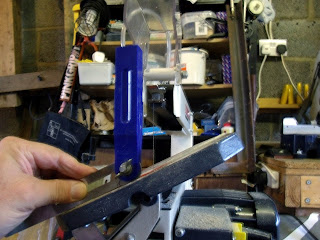OK, with a couple of sets of photocopied plans, it's time to get a start. To plunge-mould the hull, I'll need a master. Here goes!
First, I cut a nice piece of 20mm thick straight-grained timber a bit longer than the longest dimension of the hull, trying to avoid knots wherever possible.
Timber blank, ready to go
Next, I glued a deck plan onto the top, and drilled two small holes, at a couple of marked points.
Blank with top plan in place
Where these points are doesn't matter, (I picked where the hull contour lines met the centre line) provided they're lined up on both bits of the plan. They allow you to line up the second bit of plan (glued to the bottom of the timber), by putting a couple of cocktail sticks through the timber, and spiking them through the corresponding points on the bottom plan. This has the effect of allowing you to ensure that critical things like the centre line of the hull are perpendicular.
Bottom plan, arrows show location pins
So, with the plans glued in place, it's time to rough out the hull. I used my scroll saw, as it's quick and easy, but a fret saw will serve. The first cuts are to form the outline - aim to just leave the line, so there's a little wood to work back to.
Cut in progress...
...And finished!
Next, using a sliding bevel on the plans, I set the table on the saw to allow me to rough out the hull sides. By setting this to the shallowest angle, there's no change of over-cutting the hull, especially if you stay well back from the gunwale area. You can miss out this step and go straight to carving, but it's easier to de-bulk the wood like this first if you can.
Set the angle...
...And make the cuts!
From a rough-cut hull, it was a case of working gradually with planes and spokeshaves to shape the hull. If the tools are sharp, it's pretty quick work. Doing it over a bin made cleaning up a doddle! Keep checking the hull shape, regularly. The sections drawn on the plans will act as a guide, but it must be symmetrical! The symmetry is much more important that the actual shape you get. Remember to keep doing this at all stages from now on.
Getting shipshape now.
I got to a point where I had to abandon the edged tools and go over to a rasp for final shaping and removing toolmarks.
Now that's what I call rough!
Now, some sanding, to get a really smooth finish. The random orbit sander made short work of this. Every home should have one, and not just for modelmaking, either!
A proper smoothie!
Oh dearie me!
Annoying, but not insurmountable. The best stuff for fixing these sorts of problems, I've found, is some sort of two-pack wood filler, like this one. Now, this stuff is at the obnoxious end of the scale as far as modelling materials go, particularly from a safety perspective. Both components are irritants, and it absolutely must be used in a well-ventilated area, or the fumes will whisk you away to Dingley Dell in no time flat!
The remedy for holes...
Problem solved!
A bit more sanding, and it was job done. This whole stage took about an hour overall, including the waiting time for the filler.
Job's a good 'un!
Enjoy!















